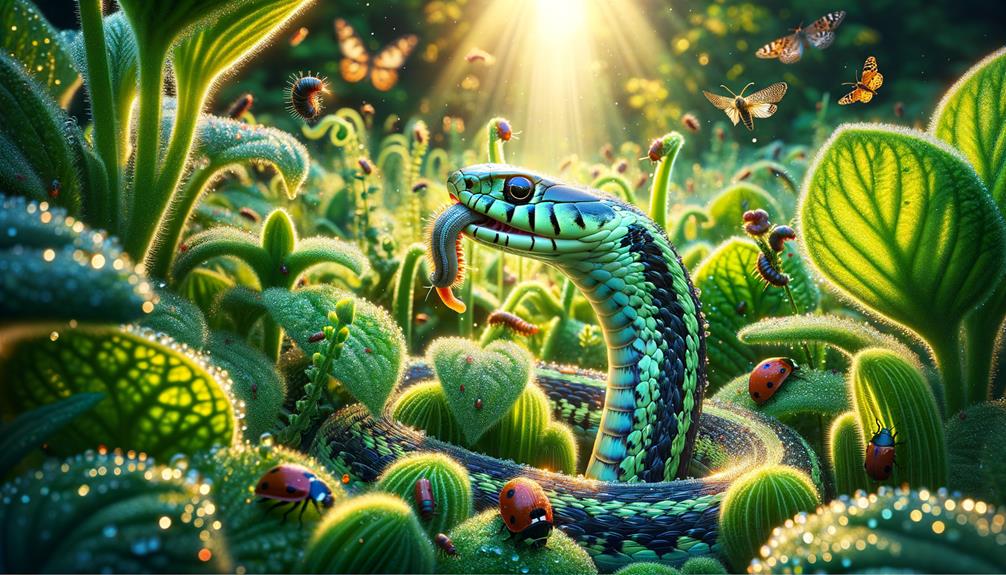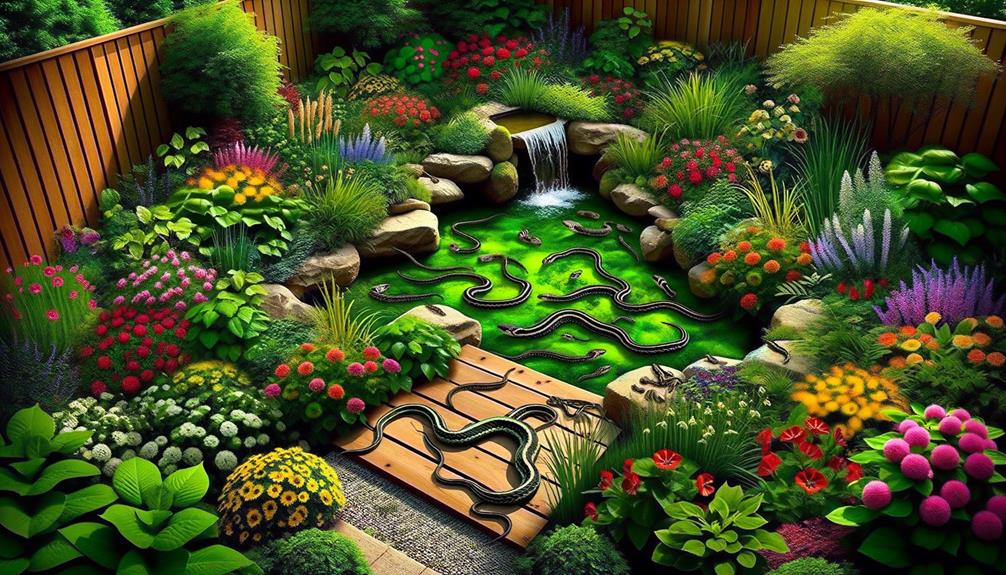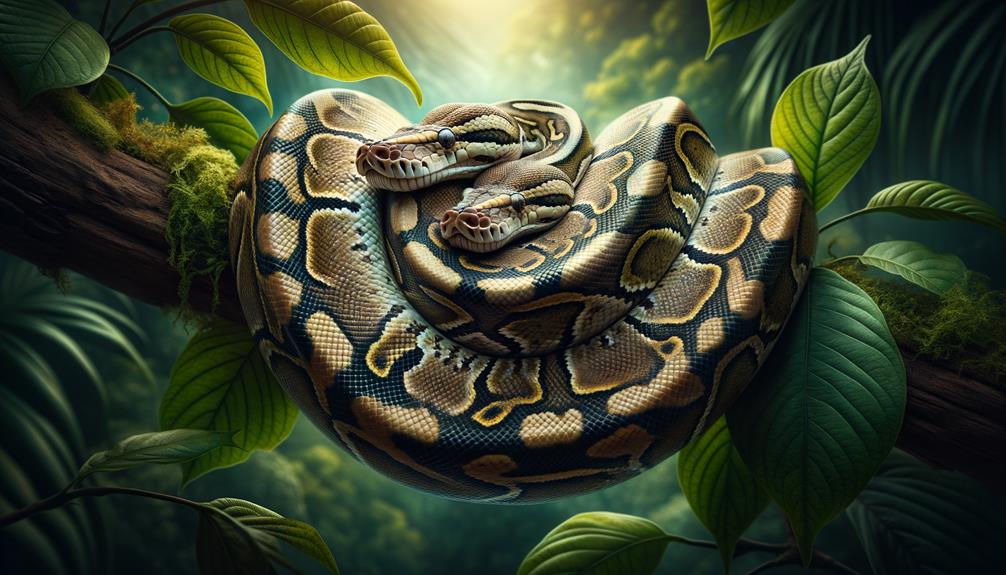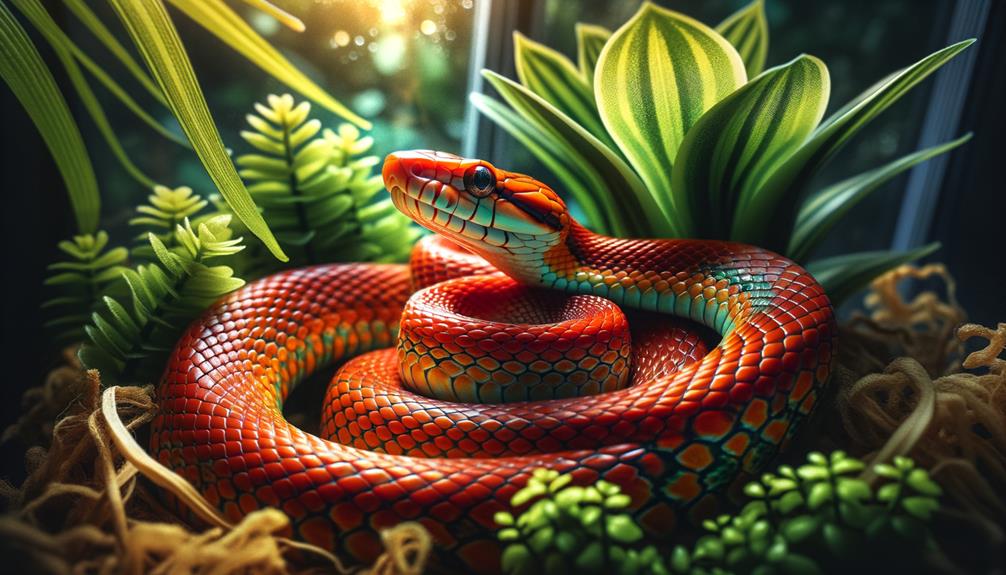I love having garter snakes in my garden because they’re fantastic pest controllers. They eat slugs, caterpillars, and even small rodents like mice and voles, keeping my plants safe and thriving. Plus, having these snakes around means I don’t need to use chemical pesticides, which is great for the environment. If you want to attract these helpful reptiles, just provide some rock piles, logs, and a water source. They’ll feel right at home, and you’ll notice a healthier, more balanced garden. There are even more benefits to discover about these amazing garden allies.
Key Takeaways
Garter snakes are a gardener’s best friend. They prey on pests like slugs, insects, and small rodents, reducing damage to your garden. By having garter snakes around, you’re supporting biodiversity and maintaining a balanced ecosystem. To attract these beneficial snakes, create a welcoming habitat by incorporating rock piles, logs, and dense vegetation for shelter. Avoid using chemical pesticides, which can harm garter snakes and other wildlife. By doing so, you’re creating a safe space for these natural pest controllers, reducing the need for chemical controls and fostering a healthy, thriving garden.
Benefits of Garter Snakes
Garter snakes are my garden’s best friends. They help control pests like slugs, insects, and small rodents, making my garden ecosystem thrive. By having these beneficial creatures around, I’ve reduced my reliance on chemical pesticides, which is a huge win for both my garden and the environment.
These snakes play a crucial role in keeping pests under control. With them around, pest populations stay in check, and I don’t have to worry about unwanted critters munching on my greens. This balance is vital; it allows me to enjoy a bountiful garden without worrying about the damage pests can cause. Plus, the fewer chemicals I use, the less impact I have on the soil and surrounding wildlife.
Encouraging garter snakes to make my garden their home has been a game-changer. They support biodiversity and help maintain a balanced environment, which is exactly what I want for my garden. By embracing these natural allies, I’ve found a liberating and highly effective way to maintain a healthy garden.
Common Garden Pests Eaten

I’m always grateful for the help garter snakes provide in keeping my garden healthy. By eating pests like slugs, caterpillars, and grasshoppers, they reduce the need for chemical pesticides. Plus, they prey on small rodents, ensuring my plants stay healthy and pest-free.
Insect Control Benefits
Having garter snakes in the garden has proven to be a great natural pest control method. These snakes feed on common garden pests, ensuring a healthier ecosystem for plants to thrive. They play a vital role in maintaining the balance of a garden ecosystem by keeping pest populations in check.
Garter snakes are particularly effective at controlling the populations of several troublesome garden pests:
- Slugs and Snails: These pests can devastate leafy greens and other tender plants, but garter snakes find them a tasty snack.
- Caterpillars: Many caterpillars chew through leaves, flowers, and fruits, causing significant damage. Garter snakes help curb their numbers, reducing the harm they cause.
- Beetles: From Japanese beetles to cucumber beetles, these insects can be quite destructive. Garter snakes consume them, aiding in natural pest management.
Rodent Population Reduction
Many gardeners are unaware of the crucial role garter snakes play in controlling rodent populations. These slender reptiles are a natural and effective way to maintain a balanced ecosystem in gardens. By preying on common pests like mice and voles, garter snakes help minimize the damage these pests cause to crops and plants.
Garter snakes primarily feed on rodents, making them a valuable ally for gardeners. When they consume rodents, they reduce the damage these pests cause to gardens. This natural predation is vital for a healthier garden environment.
| Rodent Species | Impact on Garden |
|---|---|
| Mice | Damage to crops and plants |
| Voles | Root system destruction |
| Rats | Spread of diseases |
| Chipmunks | Burrowing and eating plants |
| Squirrels | Stealing seeds and bulbs |
Garter snakes are an essential part of a healthy garden ecosystem. By controlling rodent populations, they help gardeners grow thriving crops and maintain a balanced environment.
Identifying Garter Snake Species

Spotting the differences between garter snake species can be both fascinating and rewarding, especially when you know what distinct characteristics to look for. These non-venomous snakes come in a variety of patterns and colors, making each encounter unique.
You might encounter the following types of garter snakes:
- Common Garter Snakes (Thamnophis sirtalis): Found across North America, these snakes have three light stripes running down their narrow bodies. They’re great allies in the garden, helping control rodents and insects.
- Eastern Garter Snakes (Thamnophis sirtalis sirtalis): Mainly found in the Southeast US, these snakes have dark bodies with lighter yellow stripes. They’re adaptable to various habitats, making them frequent backyard visitors.
- San Francisco Garter Snakes (Thamnophis sirtalis tetrataenia): This endangered species boasts striking black and red stripes with an orangey-red head and a light turquoise underbelly. Spotting one is a rare and thrilling experience.
Attracting Garter Snakes

To create a welcoming habitat for garter snakes in my garden, I focus on building a snake-friendly environment. I incorporate rock piles, logs, and dense vegetation to provide them with shelter and a place to hunt. A mini-pond or water source is also essential, as snakes need access to water for drinking and hunting. I also ensure a diverse range of plants and insects are present, which serves as a food source for the snakes. By avoiding chemical pesticides, I create a safe haven for these beneficial snakes and support a balanced garden ecosystem.
Suitable Habitat Features
Creating a welcoming habitat for garter snakes involves strategically placing rock piles, logs, shrubs, and trees throughout your garden to provide hiding spots and sunning areas. Garter snakes thrive in environments that offer a mix of cover and basking spots, helping them regulate their body temperature and evade predators. To attract these beneficial reptiles, consider the specific needs of your local garter snake species and gradually expand your garden’s habitat features.
Three key elements to include are:
- Rock Piles and Logs: Position these in sunny locations to create ideal basking sites. They provide essential hiding spots and sunning areas for garter snakes.
- Water Sources: Mini-ponds or shallow dishes scattered throughout the garden offer necessary hydration and attract prey, making your garden more appealing to garter snakes.
- Diverse Vegetation: Incorporate a variety of shrubs and trees to offer cover and foraging opportunities, ensuring your garden remains an inviting habitat year-round.
Natural Food Sources
Creating an appealing garden for garter snakes starts with fostering a rich ecosystem teeming with natural food sources. These creatures form the basis of the food chain that supports garter snakes, making them invaluable garden allies for natural pest control.
To attract garter snakes, it’s essential to provide a diverse range of prey. Healthy ecosystems brimming with these food sources will naturally draw garter snakes, who in turn, manage pest populations effectively. Chemical pesticides can disrupt the food chain, diminishing the prey that garter snakes rely on, so it’s vital to avoid them.
Here’s a snapshot of how different prey supports garter snakes:
| Prey Type | Benefits to Garter Snakes | Additional Benefits to the Garden |
|---|---|---|
| Slugs | Easy to catch, abundant | Reduces plant damage |
| Snails | High in nutrients | Controls snail population |
| Insects | Varied diet options | Decreases harmful insects |
| Small Rodents | Protein-rich food source | Prevents rodent overpopulation |
Safety Around Garter Snakes

Handling garter snakes requires caution, but they’re generally harmless and rarely bite humans. These fascinating creatures are mostly non-venomous, though some subspecies have mild toxins in their saliva. Despite this, their bites aren’t harmful to humans.
When you spot a garter snake in your garden, keep an eye on them, especially around rock piles where they tend to hide. If you decide to handle one, be prepared for some defensive behaviors. Garter snakes might release a foul-smelling musk or defecate to deter you.
Some key points to remember:
- Bite Reactions: Garter snake bites can cause minor swelling and itching. These symptoms are usually not serious but should be monitored.
- Cleaning Bites: Always clean the bite wound thoroughly. If any symptoms persist, seek medical attention.
- Handling Precautions: Approach them calmly and gently. Sudden movements can scare them and trigger defensive actions.
Understanding these safety tips allows you to enjoy having these beneficial creatures in your garden while ensuring both your safety and theirs.
Creating a Snake-Friendly Garden

Transforming your garden into a haven for garter snakes begins with understanding their needs and preferences. Garter snakes require shelter, which can be provided by elements like rock piles, logs, and thick vegetation. These features not only offer protection but also recreate a natural habitat that attracts these beneficial reptiles.
Chemical pesticides should be avoided, as they can be harmful to garter snakes. Instead, opt for organic pest control methods to ensure a safe environment for them.
A diverse range of plants is vital in attracting an array of insects and small creatures that garter snakes prey upon. This abundance of food encourages them to stay and helps control pest populations naturally.
While providing hiding spots is crucial, keeping grass and vegetation trimmed can create a more open environment, making it easier for garter snakes to navigate and hunt.
Frequently Asked Questions
Are Garter Snakes Good to Have in Your Garden?
Having garter snakes in your garden can be a great idea. They naturally prey on pests like slugs and insects, reducing the need for chemical pesticides. This, in turn, supports a balanced ecosystem and promotes a healthier, more sustainable garden.
Should I Leave Garter Snakes in My Yard?
Having garter snakes in my yard is a good thing. They naturally control pests like slugs and rodents, which means I don’t need to use chemical pesticides as much. This helps maintain a balanced and healthier garden ecosystem.
Do Garter Snakes Need Companions?
Garter snakes are perfectly happy on their own. They’re solitary creatures that thrive when left to hunt and regulate their body temperature independently. What matters most for their well-being is ensuring they have access to food, water, and shelter.
Do Garter Snakes Get Along With Other Snakes?
Garter snakes are generally tolerant of other snakes, and they often coexist peacefully in the wild. In fact, they can thrive in shared habitats, especially when there’s an abundance of food. During mating seasons, they’ve even been known to get along with other snakes without issue.



